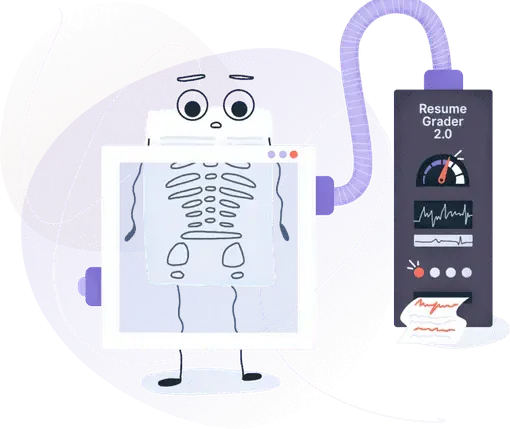Data Entry Skills for a Resume: A Complete Guide in 2025
Simplify even the most complex boards and tables with professional data entry skills.


Is your resume ATS-friendly?
Drop your resume here or upload a file to find out if the skills in your resume are readable by an ATS.
Data entry might not sound like the flashiest job skill, but in today’s fast-paced world, it’s the backbone of efficient business operations. From organizing vital company data to ensuring accuracy across platforms, data entry skills are in high demand.
Employers are looking for candidates who can handle massive amounts of information with speed and precision reliability.
So, how can you present these skills in the most impactful manner? This guide will show you how to present your data entry expertise in a way that grabs attention.
Key takeaways
- Quantify your data entry skills by showcasing typing speed, accuracy rates, and volume of data handled.
- Highlight proficiency in tools like Microsoft Excel, Google Sheets, and data management systems.
- Strengthen your experience section by incorporating action verbs like "streamlined," "validated," and "automated" to convey impact.
- Underscore certifications in Python, SQL, or AI-based software to prove your dedication to growth.
What are data entry skills for a resume?
Data entry focuses on efficiently processing and organizing information into digital systems, ensuring it’s accurate, accessible, and easy to analyze.
This skill set involves handling data from multiple sources, such as documents, spreadsheets, or digital records, and converting it into usable formats. It’s a key component in keeping operations smooth across industries like finance, healthcare, and business administration.
What data entry skills to include on a resume?
When listing data entry skills on your resume, focus on clarity and relevance. Tailor your skills to the job description, emphasizing those most valued by the employer. Hard skills work best in their own skills section, while soft skills come to life when paired with examples in your experience section.
Top 10 data entry hard skills
Below is a list of must-have hard skills for any data entry role. Highlight these with measurable outcomes in your resume.
- Computer skills
- Typing proficiency
- Microsoft Office
- Database management
- Spreadsheet expertise
- Data accuracy and validation
- Document scanning and uploading
- Keyboarding speed
- Data analysis
- File management
Top 10 data entry soft skills
These are the most common soft skills in data entry roles. Incorporate them into your resume summary and work experience descriptions.
Fastest Typist in the World
The fastest typist, according to the Guinness World Records, reached a speed of 212 words per minute, proving the extreme efficiency possible in the field of data entry.
How AI and automation are changing data entry skills for resumes
With the rise of artificial intelligence and automation, many industries now integrate AI-powered tools to enhance data entry tasks. Outlining your ability to use AI tools, such as optical character recognition (OCR) systems or machine learning-based automation software, can set you apart.
If you’ve worked with AI-enhanced systems, mention these to prove your adaptability to evolving technologies. Even for entry-level roles, knowledge of how AI can optimize workflows demonstrates a forward-thinking mindset.
As industries increasingly rely on data accuracy and speed, your familiarity with AI tools positions you as a valuable candidate who can navigate and optimize technology-driven environments.
Underlining your accuracy and AI expertise is key. Here’s a sample resume to guide you.
Resume sample for showing data entry skills on a resume
Tina Gable’s resume shows how simple and effective a resume can be. With our free template and AI resume builder, you’ll have no trouble putting together one that reflects your own strengths.
Tina Gable
Data Processing Clerk
(512) 555-9876 | t.gable@enhancv.com | @LinkedIn | Austin, TX
Summary
Detail-oriented Data Processing Clerk with 4 years of experience managing and analyzing datasets exceeding 50,000 entries per month. Streamlined data entry processes to reduce processing time by 30% while maintaining 99% accuracy under tight deadlines. Proficient in using specialized software and tools, including Excel, SQL, and ERP systems, to optimize workflows. Collaborated with cross-functional teams to enhance data-driven decision-making and improve operational efficiency by 20%.
Experience
Data Processing Clerk
Dell Technologies, Austin, TX
January 2023 – Present
- Input and maintain records for over 30,000 monthly transactions, reducing errors by 20%.
- Implement advanced Excel tools to enhance data validation processes, improving data integrity by 25%.
- Work cross-functionally with IT and operations teams to enhance the database workflow.
Junior Data Processing Clerk
Hewlett-Packard (HP), Houston, TX
June 2020 – December 2022
- Managed and processed daily data entries with 99% accuracy across multiple systems.
- Developed and executed Excel macros to automate repetitive tasks, reducing manual work by 12 hours weekly.
- Provided guidance and support to new hires during onboarding and training phases.
Education
Bachelor’s Degree in Information Systems
University of Texas at Austin
Graduated: 2020
Certifications
- Microsoft Office Specialist (Excel Expert) (2020)
- Certified Data Management Professional (CDMP) (2021)
- Google Data Analytics Professional Certificate (2022)
Skills
- Data Entry and Verification
- Advanced Excel (Pivot Tables, Macros, VLOOKUP)
- SQL Database Management
- Attention to Detail
- Workflow Automation
Languages
- English (Native)
- Spanish (Working proficiency)
See how ATS-friendly your resume is with Enhancv’s free and fast checker.
Is your resume good enough?
Drop your resume here or choose a file. PDF & DOCX only. Max 2MB file size.
Where to put data entry skills on a resume
You might be wondering how to effectively showcase your data entry skills in today’s AI-driven job market.
Highlight your expertise in automating tasks and ensuring seamless information flow to make a strong impression and secure your next role.
- Use the summary to underscore key data entry skills by mentioning tools and core strengths. For example: “Skilled in handling high-volume datasets using Excel and database software, ensuring 98% accuracy and timely completion.”
- In the experience section, focus on achievements that illustrate your skills. For instance: “Standardized and validated a database of over 75,000 entries, reducing errors by 35%.”
- Show your applied expertise in a projects section by detailing relevant contributions. For example: “Led a team project to clean and organize legacy data, improving retrieval efficiency by 20%.”
- Add an achievements section to emphasize measurable success. For example: “Improved data entry speed by 30% through optimized workflows and training programs.”
PRO TIP
Boost your resume with certifications in Excel, SQL, or AI-driven data tools from platforms like Coursera or LinkedIn Learning to display your commitment to growth.
How to present data entry skills in the summary
The resume summary is your spotlight moment to shine as a data entry pro. It’s your chance to draw attention to your razor-sharp precision and mastery of modern tools like AI-powered software.
Here you should outline standout achievements, name-drop tools that show your expertise, and tweak it to mirror what the employer is really after.
The example below works because it combines proven achievements, tool expertise, and alignment with key employer priorities like efficiency and accuracy.
How to present data entry skills in the experience section
Your experience section is where you bring your data entry skills to life. Explain how you’ve applied these skills in previous roles, using specific numbers and examples. Underscore your ability to handle large volumes of data, ensure accuracy, and streamline processes. Include action verbs and metrics to make your accomplishments stand out.
Here’s an example:
- •Entered and verified data from 1,000+ records daily with 99.8% accuracy using advanced database systems.
- •Automated repetitive tasks using Excel macros, reducing data processing time by 25%.
- •Collaborated with cross-functional teams to update and maintain the company’s CRM, ensuring seamless information flow and accessibility.
- •Trained 5 new team members on company data entry standards and software, improving team productivity by 15%.
How to present data entry skills in an achievements section
Tailoring your achievements section to the job you’re applying for is a smart move. Let’s consider, for example, an accounts clerk's resume. Focus on how your data entry skills have contributed to accurate financial records, on-time reporting, and smoother processes.
Here’s how they illustrated their achievements:
Let’s explore how data entry skills evolve from interns to junior professionals.
Data entry skills progression for interns and juniors
Starting a career in data entry often begins with learning the basics and builds toward more complex tasks as you gain experience. As an intern, you may focus on mastering foundational tools and processes, while junior professionals take on responsibilities that involve greater independence and impact.
Intern examples:
- Organized and inputted data for various client projects, ensuring consistency and accuracy across all entries.
- Supported senior staff by standardizing and cleaning raw datasets for efficient reporting workflows.
- Contributed to the testing and adoption of automation tools to optimize data entry processes.
Junior examples:
- Managed daily data entry tasks for multiple teams, ensuring timely and accurate record updates.
- Conducted regular quality checks on records to maintain high standards of accuracy and reliability.
- Collaborated with colleagues to enhance data management procedures, resulting in more efficient workflows.
How to quantify data entry skills
Quantifying your achievements makes your resume stand out. Numbers provide clear evidence of your impact and show how you save time or improve accuracy. All this adds credibility and highlights your value.
Best practices for measuring data entry skills
- Outline time efficiency: Streamlined data entry processes, reducing task completion time by implementing automation tools.
- Showcase volume of work: Managed and updated thousands of records monthly, ensuring real-time database accuracy.
- Demonstrate accuracy: Maintained data accuracy and integrity across multiple systems by implementing detailed quality checks.
- Illustrate cost savings: Reduced overhead costs by optimizing data validation workflows, minimizing errors and rework.
- Prove technology proficiency: Introduced advanced tools like OCR systems, streamlining document processing and improving data entry speed.
- Show impact on decision-making: Provided error-free data to decision-makers, enabling timely and informed business strategies.
Five tips on how to improve your data entry skills
No matter whether you’re a seasoned pro or new to the data entry field, it’s normal to feel a little unsure of your skills—especially with AI evolving so fast. But here’s the good news: there are plenty of ways to level up and stay ahead of the game.
With data driving so much of what we do today, strong data entry skills ensure you remain relevant and ready to adapt to new challenges.
Read our practical tips below:
- Boost your typing speed and accuracy: Use tools like TypingClub or Keybr, and master keyboard shortcuts to streamline your workflow.
- Learn advanced software skills: Familiarize yourself with tools like Excel, Google Sheets, and OCR software to handle diverse data tasks efficiently.
- Explore data backup solutions: Understand how to safely back up and restore data to prevent accidental loss.
- Stay updated with technology: Explore new data management tools and take online courses to keep your skills relevant.
- Build patience and concentration: Practice mindfulness techniques or start with smaller tasks to improve your focus and endurance over time.
Frequently asked questions about data entry on a resume
How can I demonstrate my ability to handle confidential information?
To show your ability to manage confidential information, underline roles where you worked with sensitive data and adhered to privacy regulations or protocols. Mention any training or certifications in data security or compliance, as these reinforce your reliability in handling such responsibilities.
Is it important to include volunteer work related to data entry?
Including volunteer work in data entry is valuable, especially for those with limited professional experience. It demonstrates the practical application of your skills, showcases your initiative, and provides examples of your ability to contribute meaningfully to an organization’s goals.
Should I be familiar with programming languages for data entry?
While not mandatory for basic data entry roles, familiarity with programming languages like Python or SQL can be an asset, especially for roles involving automation and data processing. Learning these skills can also create career opportunities in data-related fields.
Conclusion
Data entry skills are foundational in today’s tech-driven world, valued across industries for ensuring accuracy and efficiency. With the right approach, you can open doors to roles where precision is key, establishing yourself as a valuable contributor in any organization.
Make one that's truly you.




